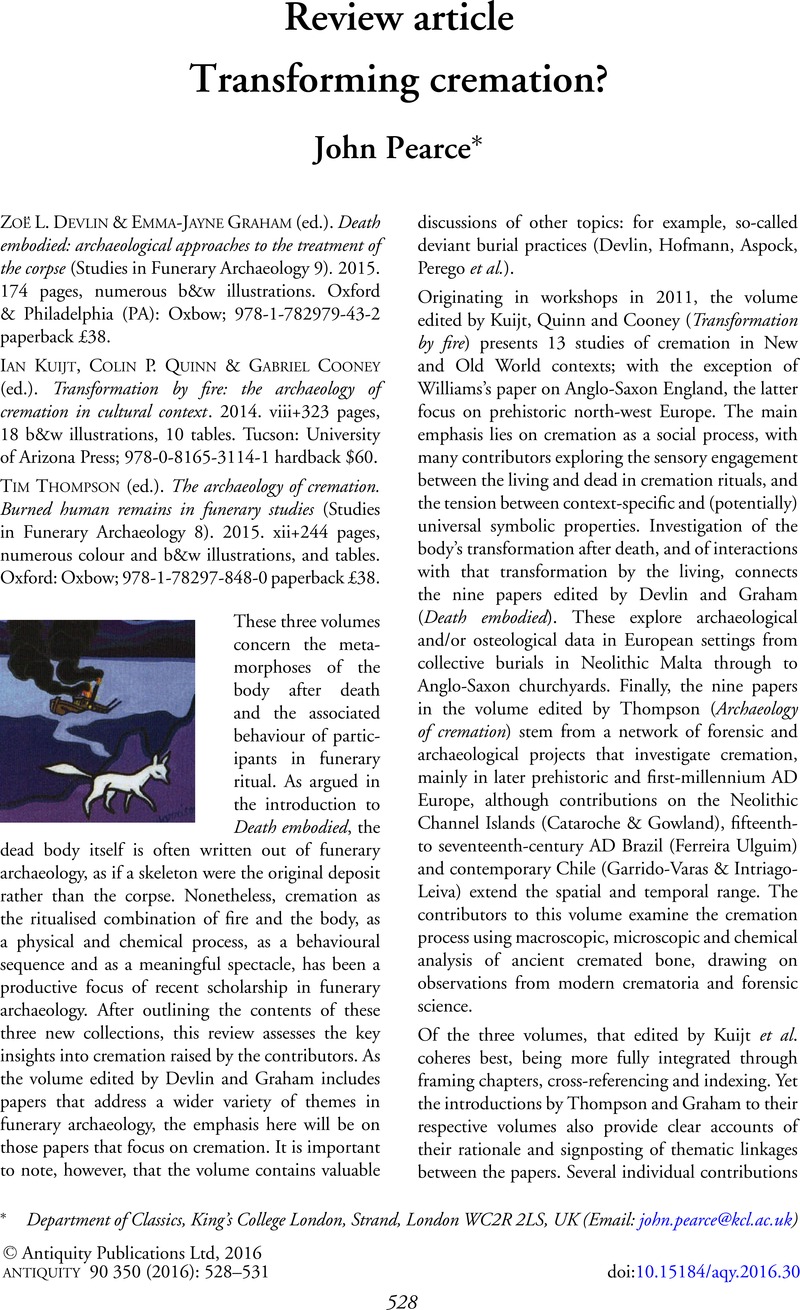No CrossRef data available.
Article contents
Transforming cremation?
Review products
Zoë L.Devlin & Emma-JayneGraham (ed.). Death embodied: archaeological approaches to the treatment of the corpse (Studies in Funerary Archaeology 9). 2015. 174 pages, numerous b&w illustrations. Oxford & Philadelphia (PA): Oxbow; 978-1-782979-43-2 paperback £38.
IanKuijt, Colin P.Quinn & GabrielCooney (ed.). Transformation by fire: the archaeology of cremation in cultural context. 2014. viii+323 pages, 18 b&w illustrations, 10 tables. Tucson: University of Arizona Press; 978-0-8165-3114-1 hardback $60.
TimThompson (ed.). The archaeology of cremation. Burned human remains in funerary studies (Studies in Funerary Archaeology 8). 2015. xii+244 pages, numerous colour and b&w illustrations, and tables. Oxford: Oxbow; 978-1-78297-848-0 paperback £38.
Published online by Cambridge University Press: 06 April 2016
Abstract
An abstract is not available for this content so a preview has been provided. Please use the Get access link above for information on how to access this content.

Information
- Type
- Review
- Information
- Copyright
- Copyright © Antiquity Publications Ltd, 2016
References
Challinor, D.
2010. Charcoal and charred remains from the cremation burials, in Booth, P., Simmons, A., Boyle, A., Clough, S., Cool, H.E.M. & Poore, D. (ed.) The Late Roman cemetery at Lankhills, Winchester. Excavations 2000–2005 (Oxford Archaeology 10): 437–43. Oxford: Oxford Archaeology.Google Scholar
Coubray, S.
2013. Combustibles, modes opératoires des bûchers et rituels. L'analyse anthracologique, in Andringa, W. van, Duday, H. & Lepetz, S. (ed.) Mourir à Pompeii—fouille d'un quartier funéraire de la nécropole de Porta Nocera (2003–2007) (Collections de l'École française de Rome 468): 1433–50. Rome: École française de Rome.Google Scholar
McKinley, J.
2013. Cremation: excavation, analysis and interpretation of material from cremation-related contexts, in Tarlow, S. & Stutz, L. Nilsson (ed.) The Oxford handbook of the archaeology of death and burial: 147–71. Oxford: Oxford University Press. http://dx.doi.org/10.1093/oxfordhb/9780199569069.013.0009
Google Scholar
Pitts, M.
2015. Official: the Ministry of Justice employs no druids. Society of Antiquaries Online Newsletter 353. Available at: http://bit.ly/209nXTA (accessed 15 January 2016).Google Scholar
Scheid, J.
2007. Sacrifices for gods and ancestors, in Rüpke, J. (ed.) A companion to Roman religion: 263–71. Oxford: Blackwell. http://dx.doi.org/10.1002/9780470690970.ch19
Google Scholar
van Andringa, W., Duday, H. & Lepetz, S. (ed.). 2013. Mourir à Pompeii—fouille d'un quartier funéraire de la nécropole de Porta Nocera (2003–2007) (Collections de l’École française de Rome 468). Rome: École française de Rome.Google Scholar
Veal, R.
2013. Fuelling ancient Mediterranean cities: a framework for charcoal research, in Harris, W.V. (ed.) The ancient Mediterranean between science and history (Columbia Classical Studies 39): 37–58. Leiden & Boston (MA): Brill.Google Scholar

